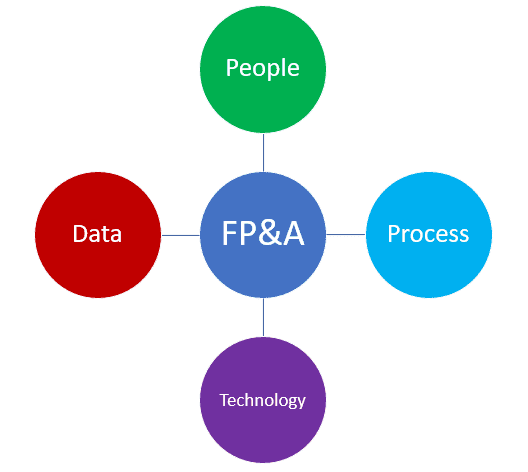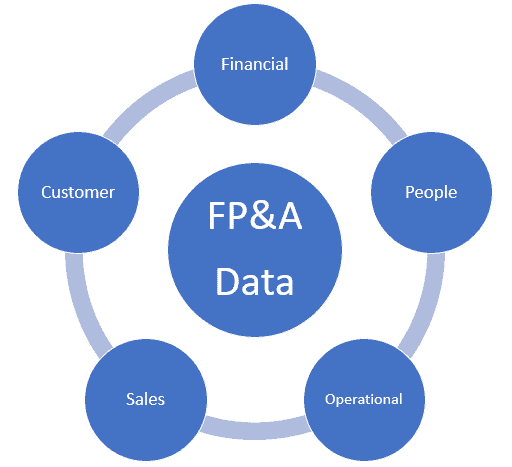As SaaS companies scale, there is an important function that must be added to your finance org chart. This function is the financial planning and analysis (FP&A) department. I rose through the ranks of the FP&A in public companies, so I have experienced all shapes and sizes of this critical department.
Fundamentally, an FP&A team is a department that supports an organization’s financial health. This involves budgeting and forecasting, performance measurement, pro-forma analyses and forecasting/modeling.
FP&A departments are common in large organizations. However, in small, private SaaS companies, you commonly do not see an FP&A analyst on the org chart. FP&A activities are either not being done or they are performed by an outside firm, a controller, or the CFO.
In this post, I’ll explain the core elements involved in the FP&A process so that you understand what needs to be done when you are ready for your first FP&A hire.
The Core Components of the FP&A Function
When I am rebuilding a finance department, I focus on people, process, and technology. These are the key components in building and scaling the FP&A function.
The modern SaaS CFO must also add data a fourth leg to the SaaS chair. Although we don’t own the data strategy, we have become data stewards. Finance departments are thirsty for data. And not just financial data. We require people, operational, sales, and marketing data to complete the financial picture.
Quality data allows us to understand the underlying activity of the business. It permits the pricing, costing, and profitability of any activity – prospectively or perspectively.

FP&A Process
The Financial Reporting Framework
FP&A follows a strict monthly routine. Once the books are closed, typically by the accounting function, the financial planning process kicks into gear. Through a reporting framework, we use financial, HR, operational, and sales data to tell the financial story of our company. We measure and explain why we hit or missed targets and benchmarks.
The monthly reporting package typically includes the sections below. Don’t be intimidated by this list. It takes time to create this framework. I wish that I could prioritize the order of this list. All are necessary but if I had to pick, I’d say forecasting. You must make sure there is enough cash in the bank.
- Monthly, quarterly, and year-to-date (YTD) income statements (P&L)
- We compare actual performance to budget and/or forecast
- Material variances to budget, whether good or bad, are explained via commentary.
- This tests FP&A’s understanding of our performance. Why did we miss or make?
- Trended balance sheet and cash flow statement
- Financial statement forecast
- Another big job of FP&A
- We forecast the P&L, balance sheet, cash flow statement, headcount, bookings, and related SaaS metrics
- Historical SaaS Metrics
- We cover some of the big ones. Churn, retention, LTV/CAC, CAC payback, Cost of ARR, etc.
- These can be compared to budget, YOY, and/or trended if applicable.
- The point here is to provide context to the metric. Trending up or down. Worse or better than budget. Metrics in isolation do not mean much.
- Headcount trends
- An often overlooked report.
- Headcount by department by month and how this compares to budget and/or forecast
- Bookings report
- ARR/MRR by new business, expansion, and downgrades
- Dollars and customer counts
- Also track for your other revenue streams. For example, professional services.
- Standard financial metrics
- A/R and A/P balances, days sales outstanding (DSO), days payables outstanding (DPO)
- Top 5 A/R customer balances who are 60+ days late
- SaaS metrics benchmarks
- Benchmarks establish a financial “lane” for our business
- Are we operating in the lane or out of the lane?
- Great sources for benchmarks included RevOpsSquared.com, Keybanc SaaS Survey, and SaaSBenchmarks.com
Remember, baby steps. You cannot produce this overnight if these reports and metrics do not exist today. Following the framework above will lead you through a discovery process.
The FP&A Data Discovery Process
- What data am I missing?
- What data cannot be trusted?
- Where does this data reside?
- Who is the owner of the data?
- What systems and/or processes should track this data?
This monthly report can range from five to twenty pages. Of course, the purpose of this financial package is to tell a story that may form the basis of decision making, not just crunch data for the fun of it.
I review the major components and highlights of this monthly package with the Board and/or CEO/founder.
Dreaded Budget Season
You know what I’m talking about FP&A folks. If you are on a calendar year, budget season begins in October and ends in December with a formal budget presentation to the Board.
Even with software, if budget season is not painful for you, you have not dug deep enough into the numbers. When I was in the FP&A department of a Fortune 20 company, we had to produce the dreaded budget memo.
Not only did we draft budget slides, but we also typed a two-page budget memo that explained the financial story of the budget. It covered bookings, revenue by product line, gross margins, OpEx profile, and related financial metrics. This was painful, but it was a true test of our understanding of the business.

They are lovers and haters of the budget process. I know some call for the complete dissolution of budget season. However, I believe it serves a purpose; to make leadership think deeply about their departments and the resources needed to achieve department and corporate goals. It tests your leadership’s understanding of the business.
And as you enter the new fiscal year with a formal budget, you can measure your performance against your leadership’s assumptions and plans. It exposes areas of your business where you need to improve financial and/or operational transparency.
Forecasting
Forecasting is a major duty of your FP&A team. It’s like the speed-dating version of the budget process. Every month you roll forward (update) your forecast with the latest actual data and operational assumptions from your team. The forecast process updates assumptions around hiring, non-wage operating expenses, and your bookings/sales.
On a monthly basis, I meet with my leaders in HR, sales, and marketing.
- Why HR? Headcount is constantly changing with new hires and attrition
- Why sales? I need the current quarter and next quarter’s ARR commit number.
- Why marketing? Marketing typically has the largest non-wage discretionary budget. Trending their forecast based on historicals will not be accurate.
Once a draft of the forecast is complete, I’ll ship a copy to the CEO for review before we publish in the monthly Board deck. In the forecast, I’m reviewing revenue growth, margin trends, cash flow, and key SaaS metrics. I need to understand what changed versus the prior forecast and why it changed.
FP&A Technology
This has become a hot space for software vendors. It’s also challenging because FP&A requires multiple data sources. As described above, we need to compile financial, operational, HR, and sales data into our reporting and analysis.
Your core accounting system does not provide FP&A functionality. It requires a “bolt-on” solution or another module in your ERP software. This software can slice and dice historical data and provide a process to gather your forecast and budget data.
I’ve used IBM Planning and Analytics (back in the TM1 days; the pre-cursor) and Jedox. I really like these tools because there is a heavy integration to Excel. However, times are changing, and you are seeing new vendors enter the space.

I’ve spoken with the co-founders at both Mosaic.tech and Pry.co. Great solutions for growing SaaS companies who want to start the FP&A process. You also have tools such as Prophix and Vena Solutions. Great solutions when you have a team of FP&A analysts.
At some point in the manual spreadsheet FP&A process, you will become overwhelmed. FP&A tools are a game changer for faster, better, and more efficient analysis. I love spreadsheets but they don’t scale. However, I did move a $1B company from spreadsheets to an FP&A tool. The breaking point is different at every company. It is much better to have software versus spreadsheets, however, unless your processes are established and documented, I would recommend establishing the latter before purchasing any budgeting software.
People
Like any department in a SaaS company, people are the true asset who execute on data, process, and technology. In the early stages, your CFO will hire an FP&A analyst. The analyst takes on the FP&A “dirty” work. Reporting, forecasting, budgeting, and so on.
As your company grows, you hire additional analysts. In large public companies, you may have analysts, managers, directors, and VP’s in the FP&A department. You have analysts who are dedicated to specific departments rather than the entire organization.

Your first FP&A analyst hire must, of course, be detailed oriented. They must be comfortable with large data sets and making sense of the data. They must translate data into the story of the business.
Traditionally, FP&A teams, just like accounting, were housed in the corporate office. Today, that’s changing with the pandemic. With a proper structure, FP&A teams can be distributed.
I experienced this years ago in the tech division of a Fortune 20 company. FP&A teams were located in the corporate HQ and supported stand-alone business units in the field. But honestly, nothing can replace walking down the hall to chat with your department leaders.
CFO’s as Data Stewards
Finance departments love data. Armed with data, finance can act as the financial architect of value creation. The CFO understands where investments must be made in the business to drive growth and value. Although we may be drowning in data, do not underestimate the value of data.
Although CFO’s do not own the corporate data set, they must be intimately involved in the data architecture. For example, I worked extremely closely with our CRM administrator. There is a tight connection between sales and finance, especially if you are implementing a “quote to cash” process.

If you are a finance leader and not involved in the flow of data within your organization, you must insert yourself and voice your opinion.
Tapping into the financial, operational, HR, and sales data allows a CFO to improve his or her “contextual awareness.” CFO’s must gain a global understanding of their business. This allows them to analyze decisions with all available data.
How Has FP&A Changed
The pandemic exposed weaknesses in many areas of our business. FP&A took the brunt of that exposure through increased demands for data and insight. Finance leaders had to examine their process, tools, and skill sets to make sure they could adapt to rapidly changing business conditions.
The pandemic has accelerated the learning process. It has also exposed weaknesses. Quickly changing external forces have required a more agile and efficient forecasting process. If your model was clunky and slow, this created major headaches when trying to scenario plan. If one forecast was hard previously, how about providing the Board with a worst case, base case, and best case forecast?
The increased demands and faster turnaround times for guidance have also increased the importance of data integrations. We reduce processing time and errors when we can move from manual CSV downloads to integrations in our FP&A software.
The pandemic has also exposed the sometimes generic nature of consolidated forecasts. I follow the 80/20 rule with forecasting. A lot of detail and logic goes into the major revenue and expenses. However, with better data, forecast model accuracy can be improved.
FP&A teams may need to provide insight into geographic and product performance, for example. This requires a retooling of our model and process to provide insights at these “local” levels. This also has the benefit of enhancing collaboration between finance and operations at different levels within our organization.
Summary
Leading finance departments not only provide financial insights but also influence enterprise value creation process. As SaaS companies scale, the data grows and so does the complexity of the business.
FP&A teams distill the operations and data of the business into the financial picture. They become a key business partner not only to the executive team but also to department leaders. They provide critical feedback in the decision-making process and push back when necessary to improve outcomes.
I have worked in finance and accounting for 25+ years. I’ve been a SaaS CFO for 9+ years and began my career in the FP&A function. I hold an active Tennessee CPA license and earned my undergraduate degree from the University of Colorado at Boulder and MBA from the University of Iowa. I offer coaching, fractional CFO services, and SaaS finance courses.

Exceptional article, Ben. Thanks for all the insights!
Really fascinating overview, many thanks Ben.
Very useful!
Ben, thanks a lot.
Helpful as usual!
Thankyou so much ben for this article!!